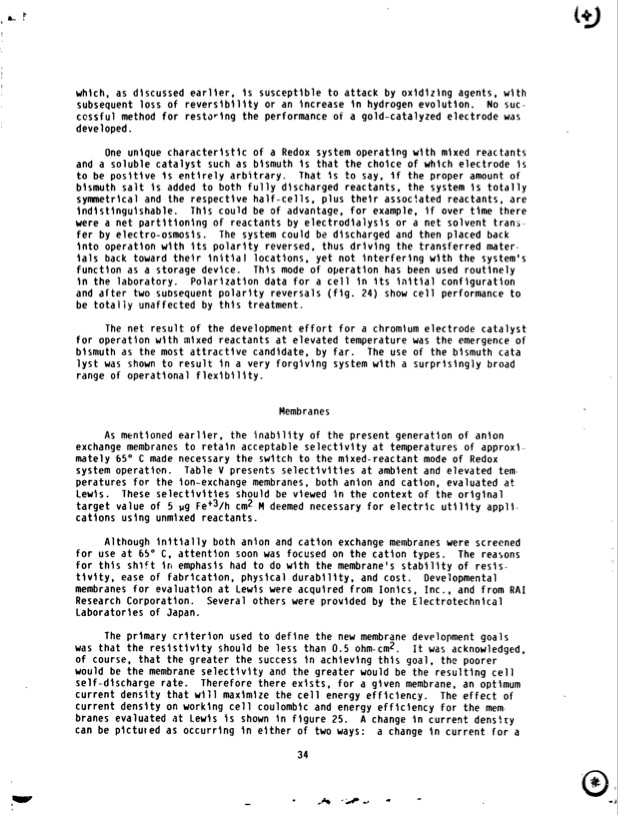
PDF Publication Title:
Text from PDF Page: 037
which, as discussed earlier, I s susceptible to attack by oxidizing agents, with subsequent loss of reversibllity or an increase i n hydrogen evolution. No suc- cessful method for restoring the performance of a gold-catalyzed electrode was developed. One unique characteristic of a Redox system operating with mixed reactants and a soluble catalyst such as bismuth i s that the choice of which electrode i s to be positive is entirely arbjtrary. That Is to say, i f the proper amount of bismuth salt is added to both fully discharged reactants, the system Is totally symnetrlcal and the respective half-cells, plus their assoc!ated reactants, are indistinguishable. This could be of advantage, for example, i f over time there were a net partitioning of reactants by electrodialysis or a net solvent trans- fer by electro-osmosis. The system could be discharged and then placed back into operation with i t s polarity reversed, thus driving the transferred mater- ials back toward their Initial locations, yet not interfering with the system's function as a storage device. This mode of operation has been used routinely In the laboratory. Polarization data for a cell in its initial configuration and after two subsequent polarity reversals (fig. 24) show cell performance to be totally unaffected by this treatment. The net result of the development effort for a chromlum electrode catalyst for operation with mixed reactants at elevated temperature was the emergence of bismuth as the most attractive candidate, by far. The use of the bismuth cata lyst was shown to result in a very forgiving system with a surprisingly broad range of operational flexibility. Membranes As mentioned earlier, the inability of the present generation of anion exchange membranes to retain acceptable selectivity at temperatures of approxi-. mately 65" C made necersary the switch to the mixed-reactant mode of Redox system operation. Table V presents selectivities at ambient and elevated tem- peratures for the ion-exchange membranes, both anion and cation, evaluated at Lewis. These selectivittes should be viewed in the context of the original targetvalueof 5pg~e+~c/mh2Mdeemednecessaryforelectricutilityappli- cations using unmixed reactants. Although i n i t i a l l y both anion and cation exchange membranes were screened for use at 65" C, attention soon was focused on the cation types. The reasons for this shlft in emphasis had to do with the membrane's stability of resis- tivity, ease of fabrication, physical durability, and cost. Developmental membranes for evaluation a t Lewis were acquired from Ionics, Inc., and from RAI Research Corporation. Several others were provided by the Electrotechnlcal Laboratories of Japan. The primary criterion used to define the new membrane development goals was that the resistivity should be less than 0.5 ohm-cm2. It was acknowledged, of course, that the greater the success in achieving this goal, the poorer would be the membrane selectivity and the greater would be the resulting cell self-discharge rate. Therefore there exists, for a given membrane, an optimum current density that will maximize the cell energy efficiency. The effect of current density on working cell coulombic and energy efficiency for the mem. branes evaluated at Lewis i s shown i n figure 25. can be pictured as occurring In elther of two ways: a change in current for a A change i n current denslryPDF Image | NASA Redox Storage System Development Project

PDF Search Title:
NASA Redox Storage System Development ProjectOriginal File Name Searched:
19850004157.pdfDIY PDF Search: Google It | Yahoo | Bing
CO2 Organic Rankine Cycle Experimenter Platform The supercritical CO2 phase change system is both a heat pump and organic rankine cycle which can be used for those purposes and as a supercritical extractor for advanced subcritical and supercritical extraction technology. Uses include producing nanoparticles, precious metal CO2 extraction, lithium battery recycling, and other applications... More Info
Heat Pumps CO2 ORC Heat Pump System Platform More Info
| CONTACT TEL: 608-238-6001 Email: greg@infinityturbine.com | RSS | AMP |